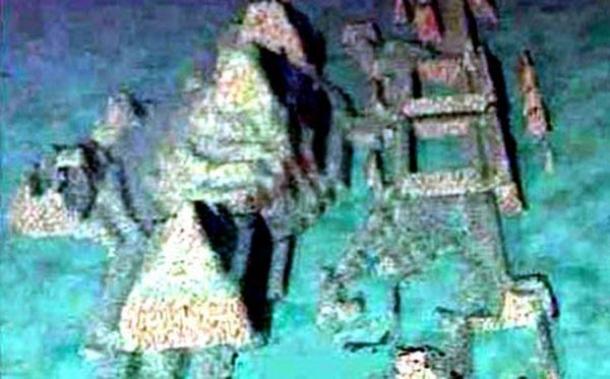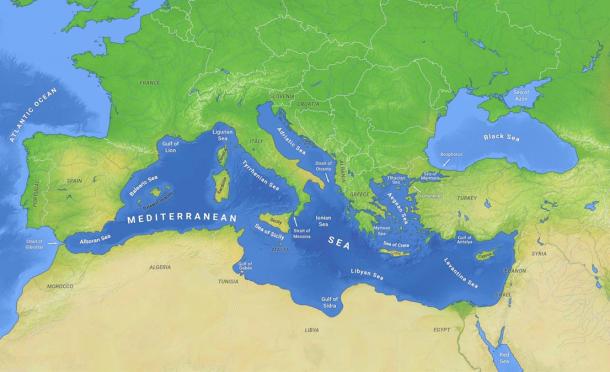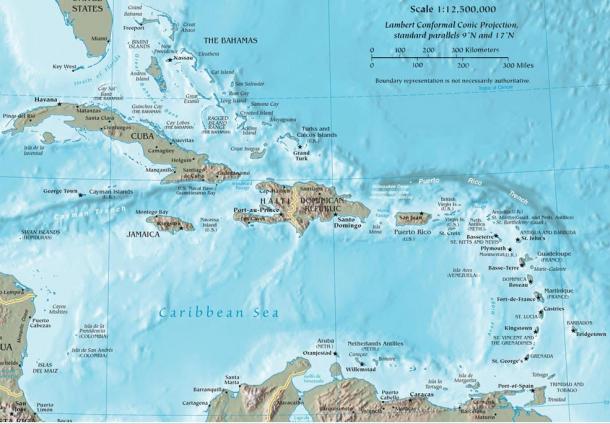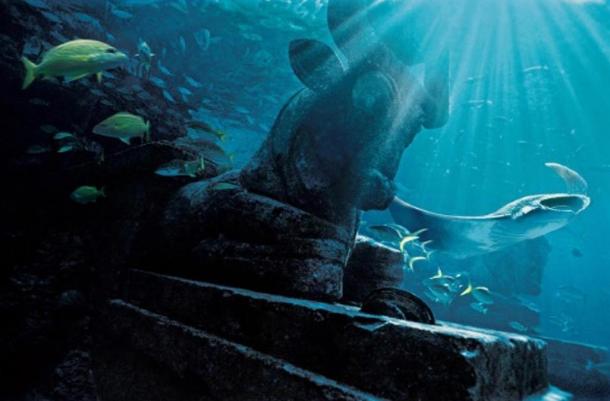
The Underwater City of Cuba: A New Theory on its Origins – Part I
In his Underworld: The Mysterious Origins of Civilization, Graham Hancock examines the numerous structures that have been discovered underwater around the world. Most of the sites that Hancock discusses lie less than 120 meters (395 feet) below sea level, which comes as no surprise since the sea level never fell below this mark during the time Homo sapiens walked the earth. Submerged over 700 meters (2300 feet) underwater, the Cuban city discovered by Paulina Zelitsky and Paul Weinzweig during a joint Cuban-Canadian expedition is the singular exception.
Overturning Old Theories
How can the existence of this underwater city at this great depth be reconciled with the well-established consensus that the sea level never dropped so low? In Hancock’s own words: “What one would not expect to find in water anywhere near as deep as 700 meters would be a sunken city - unless it had been submerged by some colossal tectonic event rather than by rising sea levels.”

Reconstructed Image from the sonar scan of the sea floor off the coast of Cuba.
However, the hypothesis that the city was originally built at a higher altitude and subsequently sunk to its present depth through tectonic activity has not stood up to the scrutiny of the experts. Grenville Draper of Florida International University considers it highly unlikely that such an event could have occurred: “Nothing of this magnitude has been reported, even from the Mediterranean…”
- What Happened to the Sunken City of Cuba?
- Ancient Submerged Cities: Rethinking Our Ancestry
- Shui-mu Niang-niang: The Old Mother of the Waters Who Submerged an Ancient City
Supposing Draper’s remarks rejecting the likelihood of the city having submerged are reliable, we are compelled to accept that the city was built at more or less the same depth that the city is located now. In other words, we are faced with the patently absurd conclusion that the structures were built underwater! Though proponents of the aquatic ape theory may beg to differ, it is clear that we have reached an impasse. Could there be an alternative theory that satisfactorily accounts for these structures at such depths?
Great Seas and Vast Depths
On the opposite site of the Atlantic Ocean from the Caribbean Sea is the Mediterranean Sea. Dividing Europe and Africa, the Mediterranean Sea is an enormous sea - over 2,500,000 km2 (965,255 square miles) that has, at least within the timeline of anatomically modern man, always existed. For millennia, ships of successive great nations and empires sailed the Mediterranean; the Phoenicians, Greeks, Carthaginians, and Romans among them. In 146 BC, owing to its victories in the Punic Wars against Carthage, Rome achieved what no known civilization had hitherto achieved; namely, the control of the entire Mediterranean Sea by a single power.

Map of the Mediterranean Sea with subdivisions, straits, islands and countries (CC BY-SA 4.0)
The Romans, rightly so, called the sea that they ruled over mare nostrum – “our sea”. Could the Romans have ever imagined that “their” sea, long before the dawn of man, was once a dry and landlocked basin? Indeed, they may very well have. In Natural History, Pliny mentions in passing a tradition of the inhabitants near the Straits of Gibraltar: “they also believe that [The Straits of Gibraltar] were dug through by him; upon which the sea, which was before excluded, gained admission, and so changed the face of nature.”

Historic map of the Strait of Gibraltar by Piri Reis. (Public Domain)
Could it be that the Caribbean Sea has a similar geological history as the Mediterranean Sea? That is, could the Caribbean Sea have been a dry basin, and could it have been so during the existence of anatomically modern man? Having performed an exhaustive search on the topic, I couldn't find a single source within the alternative literature let alone a peer-reviewed scientific paper that put forth such a hypothesis.
However implausible this hypothesis may be, if true, it would provide a simple and elegant solution to the problem discussed, namely that of how a city could have been built close to 700 meters (2300 feet) below sea level today, or 580 meters (1900 feet) below sea level even during the maximum drawdown of the world's oceans. If the Caribbean Sea simply did not exist for an extended period of time in the human past, a reasonably advanced civilization inhabiting the area could have built cities on dry land thousands of feet below sea level, even over ten thousand feet below sea level.

Map of the Caribbean Sea and Basin (Public Domain)
When the Caribbean Sea was formed, these cities would have been submerged to a depth equivalent to the depth below sea level that they were originally constructed. The Cuban underwater city would merely be one of these hypothetical cities; thus, an explanation has been provided for the existence of the city at such great depth without recourse to either the city having collapsed to its depth or it having been built underwater.
The Land and the Sea
What are the necessary conditions for the Caribbean Basin to have been dry?
First, the West Indies archipelago, instead of being a string of islands (lying above sea level) separated by numerous waterways (lying below sea level), as it is now, would have had to be a strip of land lying above sea level throughout its entire length. In other words, the Yucatan Peninsula must have been connected to Cuba via a land bridge, instead of being separated by a strait, and Cuba with Haiti, and Haiti with Puerto Rico, and so on, until finally, the island of Grenada must have been connected to the South American mainland with a land bridge, instead of being separated from it by a strait.

Perspective view of the sea floor of the Atlantic Ocean and the Caribbean Sea. (Public Domain)
Indeed, if the West Indies were like the Central American isthmus as it is today, unbroken and uniformly above sea level, the Caribbean Basin would have effectively become what geologists refer to as an endorheic basin, a basin that is isolated from the world ocean. However, the isolation of the Caribbean Basin from the larger world ocean, though necessary, is not in and of itself sufficient for it to have been dry.
- The Legendary Hyperborea and the Ancient Greeks: Who Really Discovered America?
- Submerged Temples of Mahabalipuram
- Five Legendary Lost Cities that have Never Been Found
In order for the Caribbean to have been dry, there is another necessary condition that must have been met; namely, there must have been an excess of evaporation over precipitation over the basin's watershed. Today, there is indeed an excess of evaporation over precipitation over the Caribbean region, but was this true throughout the entire time behaviorally modern humans have existed, which has witnessed a great variety of climatic conditions?
Most likely, the answer is yes, as the tropical and subtropical regions, to which the Caribbean region belongs, have undergone minimal climatic variations even amid the tumult of the ice ages and interglacials that have taken place over the Pleistocene epoch. Therefore, it is reasonable to infer that the Caribbean region had a water balance of evaporation in excess of precipitation throughout much, if not all of the human past, just as it does today.

Underwater ruins, representational image. (Saramarielin/CC BY 2.0)
Taken together, these two conditions, both of which are necessary for the Caribbean Basin to have been dry, are sufficient for this to have been so. That is, if the Caribbean Basin were both isolated from the Atlantic Ocean and evaporation exceeded precipitation over its watershed, it must have been dry.
Given that the latter condition has already been established as highly likely throughout the time period in which man existed, demonstrating that the former condition also held, shall suffice to prove that the Caribbean Basin must have been dry. Thus, we have established that the Caribbean Basin indeed could have been dry and hence habitable if the Caribbean Basin were isolated.
This begs the question: Could the Caribbean Basin have been isolated? In other words, could the West Indies archipelago, which is now an island arc interspersed with deep and numerous waterways, have once been a contiguous landmass uniformly above sea level akin to the Central American isthmus?
Read: The Exceptional Cuban Underwater City: Prehistoric Ramifications of its Origins – Part II
Top Image: Artist’s representation of underwater ruins. Source: BigStockPhoto
By Brad Yoon
Updated on June 23, 2021.
















Comments
I really like this article. But it's not the first time I've read this exact idea. I read the same hypothesis a few years ago. Unfortunately i can't remember where or by whom. Still props for keeping this idea current.
As for the christian cult having any baring on pre history. How ridiculous.
Crasslee
Just think of the possibilities inherent in Hancock’s scenario. Possible? Anything’s possible – well maybe. I’m not sure any logic would suffice to convince Jack that his interpretation of the Bible is incorrect. Barry gave it a valiant try.
I don’t understand using the Bible as the ultimate authority on any subject. Aside from the fact that any version used in this era is composed of a long string of translations and consequent variations from the original, it is complicated by the seemingly endless variety of interpretations. Look hard enough, and one can find an “authority” that would support almost any interpretation imaginable, including an Earth that’s only 6000 years old.
Jack do you think Mr Christ knew what he was talking about when he refers to his spiritual Mother and Father. Do you think you know exactly what he understood.
Quotes
Amongst the Eastern Church communities there is none more clear about the feminine aspect of the Holy Spirit as the corpus of the Coptic-Gnostic's. One such document records that Jesus says, "Even so did my mother, the Holy Spirit, take me by one of my hairs and carry me away to the great mountain Tabor [in Galilee]."
The 3rd century scroll of mystical Coptic Christianity, The Acts of Thomas, gives a graphic account of the Apostle Thomas' travels to India, and contains prayers invoking the Holy Spirit as "the Mother of all creation" and "compassionate mother," among other titles. The most profound Coptic Christian writings definitely link the "spirit of Spirit" manifested by Christ to all believers as the "Spirit of the Divine Mother." Most significant are the new manuscript discoveries of recent decades which have demonstrated that more early Christians than previously thought regarded the Holy Spirit as the Mother of Jesus.
One text is the Gospel of Thomas which is part of the newly discovered Nag Hammadi texts (discovered 1945-1947). Most are composed about the same time as the Biblical gospels in the 1st and 2nd century AD. In this gospel, Jesus declares that his disciples must hate their earthly parents (as in Luke 14:26) but love the Father and Mother as he does, "for my mother (gave me falsehood), but (my) true Mother gave me life." In another Nag Hammadi discovery, The Secret Book of James, Jesus refers to himself as "the son of the Holy Spirit." These two sayings do not identify the Holy Spirit as the mothering vehicle of Jesus, but more than one scholar has interpreted them to mean that the maternal Holy Spirit is intended.
Jack here is your quote and what you have done by changing these words is exactly what the quote is about. I am not sure if you have grasped the basic cosmological understanding of the bible. You have referred to God as "His" in your quote but God does not have a gender. Are you referring to the Father who art in Heaven.
Jack's quote changed and personalised.
God warned us in Revelation 22:19 that any who add or take anthing from His Word will spend eternity in Hell. So Islam, Jehovah’s Witnesses, and Mormon all ignore that warning at their own peril. All those cults were started hundreds of years and more after God’s Book had been completed.
19 And if any man shall take away from the words of the book of this prophecy, God shall take away his part out of the book of life, and out of the holy city, and from the things which are written in this book.
And if anyone takes words away from this scroll of prophecy, God will take away from that person any share in the tree of life and in the Holy City, which are described in this scroll.
And if anyone removes any of the words from this book of prophecy, God will remove that person's share in the tree of life and in the holy city that are described in this book.
and if any man shall take away from the words of the book of this prophecy, God shall take away his part from the tree of life, and out of the holy city, which are written in this book.
May every one who hears or reads these words, desire at once to accept the gracious invitation. All are condemned who should dare to corrupt or change the word of God, either by adding to it, or taking from it.
King James Bible
Jesus saith unto him, I am the way, the truth, and the life: no man cometh unto the Father, but by me.
Jack you have added, cut, changed the words here again, for what you personally have been taught or believe.
Jack's words though are-
"The Bible says there is one way only to get to Heaven, and that is through Jesus Christ."
Firstly there is a major difference between the words; Heaven and the Father, these are two different words and have two completely different meanings. The word through is also seriously incorrectly used.
Pages